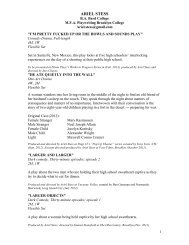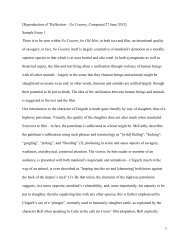Redressing Oscar: Performance and the Trials of Oscar ... - A Stess
Redressing Oscar: Performance and the Trials of Oscar ... - A Stess
Redressing Oscar: Performance and the Trials of Oscar ... - A Stess
Create successful ePaper yourself
Turn your PDF publications into a flip-book with our unique Google optimized e-Paper software.
According to Clifford Geertz, a Balinese cockfight is a "means <strong>of</strong> expres-<br />
sion." Like <strong>the</strong> trials, it provides a structure for society's <strong>the</strong>mes. The cockfight:<br />
catches up <strong>the</strong>se <strong>the</strong>mes-death, masculinity, rage, pride, loss, benefi-<br />
cence, chance-<strong>and</strong>, ordering <strong>the</strong>m into an encompassing structure,<br />
presents <strong>the</strong>m in such a way as to throw into relief a particular view <strong>of</strong><br />
<strong>the</strong>ir essential nature. It puts a construction on <strong>the</strong>m, makes <strong>the</strong>m, to<br />
those historically positioned to appreciate <strong>the</strong> construction, meaningful-<br />
visible, tangible, graspable-"real," in an ideational sense. (1973:444)<br />
Throughout, <strong>the</strong> participants in <strong>the</strong> trials contested <strong>the</strong> various interpreta-<br />
tions that could be put onto <strong>Oscar</strong> Wilde. The Queensberry trial began with<br />
literary interpretations both <strong>of</strong> The Picture <strong>of</strong> Dorian Gray <strong>and</strong> a letter <strong>of</strong><br />
Wilde's. But whereas <strong>the</strong> trial participants may have partially recognized <strong>the</strong>ir<br />
participation in a project <strong>of</strong> constructing interpretations, <strong>the</strong> one construction<br />
<strong>the</strong>y were making was undoubtedly recognized as <strong>the</strong> true <strong>and</strong> natural one<br />
<strong>and</strong> hence, paradoxically, to <strong>the</strong>m not a construction at all. The trials began<br />
with artificial structures-Wilde's novel, his character, <strong>the</strong> stories told about<br />
him-<strong>and</strong> concluded by fixing <strong>the</strong>se constructions firmly <strong>and</strong> without suture<br />
onto <strong>the</strong> body <strong>of</strong> <strong>the</strong> criminal.<br />
Cohen demonstrates how <strong>the</strong> sensational newspaper accounts systematically<br />
foregrounded Wilde's body. From describing in detail how Wilde stood in<br />
<strong>the</strong> witness box, how he clo<strong>the</strong>d himself, to, finally, how his body showed<br />
signs <strong>of</strong> deterioration by <strong>the</strong> end <strong>of</strong> <strong>the</strong> last trial, Cohen argues that what he<br />
calls "somatic displacement" became "<strong>the</strong> conduit through which <strong>the</strong><br />
unverbalized/unverbalizable aspects <strong>of</strong> <strong>the</strong> sexual charges against Wilde were<br />
made available to <strong>the</strong> reading public [...]" (1993:179). With props (cigarette<br />
cases, walking sticks, expensive dinners), costumes (blue serge suits <strong>and</strong> straw<br />
hats), traditional melodramatic characters (outraged fa<strong>the</strong>rs <strong>and</strong> rebellious sons)<br />
<strong>and</strong> drawing room settings, <strong>the</strong> trials <strong>the</strong>atrically constructed Wilde as an ef-<br />
figy <strong>of</strong> decadence <strong>and</strong> monstrous male sexuality.<br />
If, however, Wilde allowed <strong>the</strong> young men to dominate <strong>the</strong> relationships-as<br />
<strong>the</strong> courts seemed also to imply-<strong>the</strong>n Wilde<br />
would need to be expelled from <strong>the</strong> patriarchal circles in which<br />
he moved freely. Wilde would have lacked <strong>the</strong> phallus.<br />
The <strong>the</strong>mes <strong>of</strong> <strong>the</strong> trials-male privilege, fa<strong>the</strong>rhood, <strong>and</strong> class-in one sig-<br />
nificant way reconstructed <strong>the</strong> sanctity <strong>of</strong> bourgeois privacy. In ano<strong>the</strong>r sig-<br />
nificant way, <strong>the</strong>y reconstructed men's "privates." Ultimately, <strong>the</strong> trials as<br />
performed in <strong>the</strong> media caught up <strong>the</strong> "<strong>the</strong>me" <strong>of</strong> Wilde's body, reduced to<br />
<strong>the</strong> activity <strong>of</strong> his genitals. In o<strong>the</strong>r words, Wilde's body became both <strong>the</strong><br />
natural site <strong>and</strong> a citation (in terms <strong>of</strong> both an authority <strong>and</strong> deployment) <strong>of</strong><br />
his "crimes." Wilde's penis, <strong>the</strong>n, became both <strong>the</strong> site <strong>of</strong> his crime <strong>and</strong> <strong>the</strong><br />
instrument <strong>of</strong> it. Citing Wilde's body naturalized <strong>the</strong> construction <strong>of</strong> <strong>the</strong> trials<br />
<strong>the</strong>mselves; reducing his violation <strong>of</strong> gender to <strong>the</strong> activity <strong>of</strong> his penis as <strong>the</strong><br />
one prop he had in common with <strong>the</strong> men conducting <strong>the</strong> trials rendered <strong>the</strong><br />
crime underst<strong>and</strong>able to o<strong>the</strong>r men. The lowest common denominator, it be-<br />
came <strong>the</strong> only site for masculinity-its essential nature-since Wilde effec-<br />
tively inverted all o<strong>the</strong>rs. According to Cohen, "As soon as Wilde himself<br />
became <strong>the</strong> subject <strong>of</strong> legal scrutiny, it was very clear that it was his body-<br />
<strong>Oscar</strong> Wilde <strong>Trials</strong> 53




